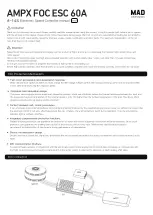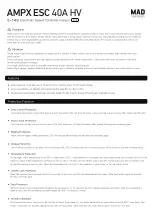
31
MARS
QUADCOPTER OPERATOR’S MANUAL
2) Making sure to install the propellers onto the correct motors as
shown in the photo at left, thread the propellers onto the motor
shafts (being careful not to cross-thread them) and finger tighten
them. The two black hub propellers are reverse thread (turn
counter-clockwise to tighten) and the two silver hub propellers
are standard thread (turn clockwise to tighten).
Your Mars series quadcopter features self-locking propellers
that only need to be finger-tightened when installed. When
you power up the quadcopter, the propellers will fully tighten and
lock into place on their own.
MAiNTENANCE
In general, your Mars series quadcopter doesn’t require much in the way of maintenance or adjustments; however,
there may come a time when you need to replace the propellers, bind the transmitter and receiver, calibrate the
transmitter control sticks, update the flight controller firmware and calibrate the camera gimbal etc. This section
covers the more common maintenance items you might encounter.
ROUTiNE MAiNTENANCE
• Before each flight check that the propellers are free of any damage (e.g., nicks, cracks, etc.)
• Periodically check that all fasteners are accounted for and tight. This includes the motor mounting screws, camera
gimbal mounting screws, and all the screws that secure the two halves of the quadcopter together.
• On a weekly basis, apply a drop or two of ball bearing oil to the motor bearings to keep the motors running
smoothly and efficiently. We recommend using Parma Bearing Oil
• Periodically clean the outside of the quadcopter and the transmitter using a damp cloth to keep them free of dirt
and debris.
• Periodically check the Power and USB connectors and related wiring to ensure they’re free of any damage. It’s
also a good idea to check your LiPo battery each time you charge it for any signs of damage or swelling.
• If you have the FPV version, periodically clean the FPV monitor LCD screen using a soft cloth and non-abrasive
screen cleaner.
Do not attempt to fly the quadcopter if one or more of the propellers is damaged. Flying with damaged propellers is not
safe and can make the quadcopter fly uncontrollably. If a propeller appears damaged (cracked, chipped or excessively
scuffed), it should be replaced. Follow the procedures in this section to replace the propellers.
Make sure to install the replacement propellers in the correct configuration or the quadcopter won’t fly.
1) To remove the propellers, firmly hold the motor case in one hand, then unscrew the propeller with your other hand.
The quadcopter features self-locking propellers. Turn the propellers with a black hub clockwise to loosen them
and turn the propellers with a silver hub counter-clockwise to loosen them.
REPLACiNG ThE PROPELLERS
biNDiNG ThE TRANSMiTTER AND RECEivER
The transmitter and receiver have been paired at the factory and are ready for use. Follow the procedures in this
section if you should ever need to re-bind the transmitter and receiver. For example, if you needed to replace the
receiver as a result of a crash or if the transmitter requires replacement.
1) Remove the propellers from the quadcopter and set them aside.
2) Using a 2.0mm hex wrench, remove the twenty-two M2.5 x 8mm chrome self-tapping screws that hold the top
and bottom halves of the quadcopter together, then carefully pull the quadcopter top half off, making sure not to
damage the GPS wiring harness.
The propellers may be quite tight when you try to remove them. Use a non-slip rubber grip pad to hold the motor
case firmly in place while unscrewing the propellers. We also recommend you wear a glove on your other hand
to keep from accidentally cutting yourself on the propeller blades.





























